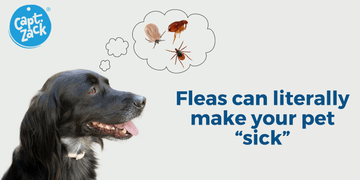They thrive in warm temperatures, which is why most pet owners despise the summer. These parasites are so resistant that they may go months without eating and survive in harsh conditions. Fleas can spread quickly and be difficult to get rid of if left untreated, causing serious illness in your dog. But if you simply medicate your pets and regularly use dog shampoo for fleas, you'll end that fiasco before it starts.
What are the symptoms of a flea infestation?
Cats and dogs make perfect hosts for bloodsucking fleas because they are warm and furry and make a comfortable nest for fleas and their eggs. If you’ve ever been a victim of fleas in your heads, you may be aware of the agony your fur baby feels when they're swarmed by fleas... Besides, pet skin is much more delicate than human skin, which amplifies their suffering even more.
The saliva of a flea is an allergen and causes severe itching and skin inflammation. It can cause dermatitis in your pet’s sensitive skin. The most common symptoms of flea infestation in your canine soulmate are:
● Excessive scratching, itching, biting, licking
● Hair loss
● Abnormal red patches of skin
● Skin sores
● Yeast and bacterial infections
● Skin Infections
● Flea dirt on dog bedding
● Ear infection
Dogs often get infested with fleas through contact with other animals or contact with fleas in the environment. This parasite's strong rear legs allow it to jump from host to host or from the environment onto the host.
Captain Zack's IRadicate tick repellent oil spray can be applied on a daily basis for round-the-clock tick protection. IR3535, a proven ingredient from Merck, Germany, is used for the first time in India for dog care products in the IRadicate tick repelling shampoo. It's a gentle yet effective insect repellent that's typically used in baby and children's products.

In any given year, more than 50 percent of dogs and cats are attacked by these
blood-sucking parasites. Fortunately, there are several methods to prevent fleas from taking up residence on your pets and becoming an annoyance for you and other pets in your home.
Tick-borne diseases
Fleas cause a number of diseases, some of which are lethal. You are exposing your pets to serious health ailments if you do not protect them against fleas. Some of the common flea diseases are:
1. Flea Allergy Dermatitis
In the United States, FAD is the most frequent skin disease in dogs. When a flea
feeds, it injects saliva into the skin of your dog. The enzymes, peptides, and amino acids in this saliva affect your dog's immune system. Excessive scratching, licking, or biting around the tail, groin, or backside are common FAD symptoms.
2. Flea-Bite Anemia
When a flea infests your cat or dog, they usually settle in and suck up their blood until they’ve had their fill. Your dog may develop anemia, or a lack of red blood cells if a significant number of fleas bite and feed on him. If the platelet count falls below 30,000, it is generally difficult to save the fur baby.
3. Bartonellosis
The Bartonella bacteria is transmitted to dogs via fleas, sand flies, lice, and ticks
which causes Bartonellosis. Multiple areas of your dog’s body can be infected with Bartonella. These include his cardiovascular, neurological, skeletal systems, and potentially his digestive system. Bartonella has also potentially been linked to deadly canine cancer.
4. Tapeworms
Fleas can carry larvae or babies of tapeworms. A mature tapeworm can grow within your dog's intestines if he swallows it, perhaps while grooming himself.
Tapeworms hook to the stomach walls and absorb nutrients as they transit through your dog's digestive tract, resulting in weight loss and nutritional deficiencies.
Flea Treatment for Dogs
The first step is to learn about your pet's behavior patterns by watching them on a regular basis. If you believe your pet has fleas, you should see a veterinarian right away before the infestation worsens.
Besides, there are various flea treatments for dogs to get rid of these blood-sucking parasites:
1. The first and absolutely most important thing you should do is to get fleas and tick meds on your pet’s coat. The flea and tick medicine on your pets' skin repels the bugs, preventing them from catching a ride on your pets.
2. Modern monthly oral and topical flea preventives are an essential part of flea
treatment for dogs. It is always advisable to take the medication prescribed by the veterinarian.
3. Gently comb a fine-toothed comb through your pet's coat to catch the fleas. To ensure they don't survive, throw them in a dish of soapy water, burn them, or flush them.
4. Using a dog shampoo for fleas once a week will also help clear your canine
friend’s coat. When it comes to flea treatments, natural is always the best option, so look for an organic pet shampoo that is free of chemicals.
Excuse Me, Fleas! Shampoo by Captain Zack Shampoo is an antimicrobial shampoo that eliminates ticks and fleas with essential oils and plant-based ingredients. The shampoo is pH balanced and free of artificial fragrances, making it ideal for your four-legged friend's delicate skin.
5. Finally, it is critical to treat your environment for ticks. Thoroughly clean your
home. Vacuum the entire floor and empty the vacuum bag as soon as possible.





